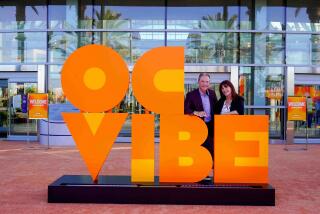Don’t Be Won by Big Promises of Pro Sports
Suddenly, professional sports seems to be everywhere in Southern California, looking for money like some gold-plated version of United Way.
The National Football League wants Los Angeles to build a new stadium, both to get another football team and to play host to a Super Bowl every three years.
In Anaheim, Walt Disney Co., which is purchasing 25% ownership of the California Angels baseball team, wants the city to pay for alterations to Anaheim Stadium.
Also, Anaheim is planning a 159-acre development called SportsTown to group a football stadium, theme park, residential community and theater and restaurant complex around its 3-year-old Pond of Anaheim arena.
The Pond, which is home to Disney’s Mighty Ducks hockey team, operates at a loss every year but nonetheless has proved a mostly successful venture that reflects many of the trends in pro sports.
Meanwhile, Los Angeles continues to plan a downtown arena for basketball’s Lakers and hockey’s Kings, although sports professionals are skeptical. “Los Angeles has been talking about a downtown arena for years,” says one.
Clearly, many trends are at work in pro sports, and yet Southern California, the country’s second-largest market, seems not to be in tune. But beware of hype and false images. Los Angeles and its people are accused of not being true sports fans, even as the Dodgers draw over 3 million baseball fans every year and 88,000 fans crowd into the Coliseum in the rain to watch a soccer match.
So with real money at stake, there are several points to keep in mind about pro sports and the outlook for Southern California.
First, sports is an attraction but not an industry. Claims that teams and events generate jobs are either inflated or irrelevant. The NFL says that the Super Bowl brings $250 million in business to a host city. But in Los Angeles, a county with $257 billion in output of goods and services, that’s not a big deal. And it means even less in the $438-billion economy of Southern California’s five counties, apart from San Diego.
A good shopping mall or manufacturing plant generates far more economic kick than a Super Bowl.
That’s not to say sports lacks value. On the contrary, a local team or a big game can bring people together and lift a community. As Fred Rosen, head of Ticketmaster and of efforts to bring an NFL team to Los Angeles, puts it: “Where else can you talk to total strangers so easily as at a ballgame?”
Lately, however, the affection between teams and communities has cooled as teams have gone from small businesses managed by amateurs to big-money arms of the entertainment industry. A prominent example is owner Art Modell moving the Cleveland Browns to Baltimore because the Ohio city wouldn’t build a new stadium.
Modell, 70, was under pressure to invest new equity in a stadium so that he could earn money from luxury boxes in order to pay star players, as owner Jerry Jones has done in Dallas. Modell declined and moved to Baltimore, where taxpayers financed a stadium.
But extortionate owners are sparking angry public reactions. Houston, Chicago, Los Angeles and Orange County have bid owners farewell or given them warning. The NFL has public relations and business problems.
“From a successful cooperative venture, the NFL is breaking into a league of haves and have-nots,” says Paul Much, a specialist in sports business at Houlihan Lokey Howard & Zukin, a Los Angeles investment bank.
Yet a return to the good old days is unlikely. Instead, corporate ownership will become the pattern in sports--and connections to gambling may become more open. ITT Corp., owner of Caesars Palace, the casino company, also owns 50% of basketball’s New York Knicks and hockey’s New York Rangers.
Readiness for gaming is partly behind the cry of sports leagues for state-of-the-art facilities, experts say--as in the NFL ignoring Rose Bowl and Coliseum in stating its requirements for a return to Southern California.
State-of-the-art now is defined by computer tie-ins, as in the new $175-million MCI Arena in Washington, where basketball’s Bullets and hockey’s Capitals will play. The MCI will feature online services to seats so that spectators can do instant replays and tap into statistics--or someday maybe place a bet.
To be sure, there are other reasons besides gambling for new facilities. The up-to-date Pond of Anaheim allows Disney to present entertainment beyond hockey. The arena, opened in 1993 at a cost of $120 million, is in use 180 nights a year, 45 of them with Ducks games. Up to a point, Anaheim doesn’t have to worry about losses because Ogden Corp., a $2.2-billion sales New York-based company, has guaranteed the debt that built the arena. Ogden in turn manages the Pond, its concessions and parking, for a fee.
To break even, the arena needs a basketball franchise, so Anaheim is trying to lure the Los Angeles Clippers to Orange County.
And that brings up Los Angeles, where the Forum and Sports Arena are among the oldest facilities in major sports. For replacements, three downtown sites are being considered--provided private financing can be found. The vision is of the Lakers and Kings, plus other attractions, drawing 17,000 customers to restaurants and shops more than 200 nights a year.
A similar vision of an urban meeting place, like Universal Studios’ successful CityWalk, imbues Anaheim’s plans for SportsTown.
Truth is, communities are placing a lot of weight on sports, as entertainment and as an engine for urban renewal. That’s why superstars like Magic Johnson and Wayne Gretzky are so important but also why team owners feel no compunction about tapping the taxpayers.
More to Read
Go beyond the scoreboard
Get the latest on L.A.'s teams in the daily Sports Report newsletter.
You may occasionally receive promotional content from the Los Angeles Times.










